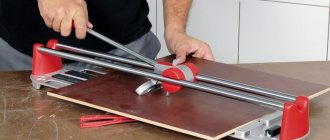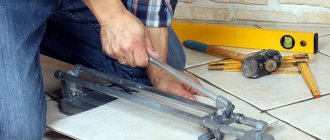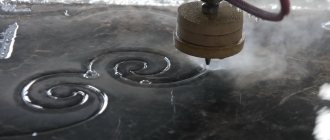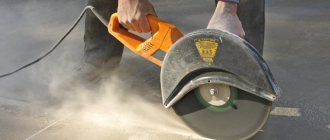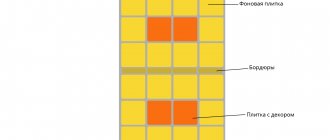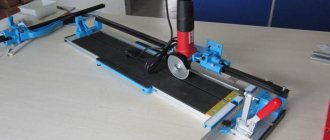Features of the material
Porcelain stoneware is a building material that is produced by pressing under high pressure and subsequent sintering at high temperature into a homogeneous mass.
The following raw materials are used to produce porcelain stoneware:
- feldspar,
- kaolin,
- quartz sand,
- clay,
- mineral supplements.
The technology is such that the resulting material has high hardness, comparable to such well-known natural materials as diamond, sapphire or ruby. At the same time, the structure of porcelain stoneware has great homogeneity and an almost complete absence of pores.
Technical features of the material:
- No accumulation of static electricity during operation.
- High strength.
- High class of environmental friendliness and hygiene, meeting all accepted international standards.
- Abrasion resistance, which is especially important in high-traffic areas.
- Resistant to temperature changes and chemical exposure.
- Fire safety.
It should be taken into account that thin porcelain stoneware tiles, having a thickness of less than 3 mm, are a fragile material and require care during installation; shock loads must be avoided.
Cutting with a grinder
People call an angle grinder an angle grinder, and it is used to process a variety of materials using cutting and grinding methods. That is why it is a universal tool and is available to most owners. Special tools are usually designed to perform one operation.
To cut porcelain stoneware into a certain size at home, using a grinder will be quite justified. The choice should be made in favor of a tool with light weight and comparable power. A heavy tool is more difficult to use, and too high speeds will allow you to complete the job faster, but can affect the quality of the cut, significantly reducing it.
The main requirement when working with an angle grinder on porcelain stoneware: the correct selection of the cutting tool, in this case, a cutting wheel.
Selecting a cutting blade
For a novice builder, the following recommendations will be useful; a cutting wheel for working with porcelain stoneware is selected according to the following parameters:
- The seat size of the cutting disc must strictly correspond to the seat of the grinding machine.
- To work with porcelain stoneware, only diamond discs are used, which are divided according to the method of applying diamond coating into solid and segmented.
How can a non-specialist choose a diamond wheel? If there is a large amount of work to be done, the best option would be to stock up on both solid and segmented ones. During the work, you will have the opportunity to try making cuts with different tools and choose the best option for the job.
When selecting a disk, significant factors are taken into account:
- The thickness and density of the material being cut, its relief and quality.
- Diamond coating density, cutting edge height, disc thickness.
You should carefully study the manufacturer's instructions and recommendations. Usually they are located on the disk itself and indicate for what purpose this cutting tool can be used.
Features of cutting porcelain stoneware with a continuous circle:
- A solid circle is used for “wet” cutting with cooling with special liquids or water. Using such a disk without cooling will lead to its rapid failure.
- For short cuts that require a high surface finish and no chipping, the solid blade can be used with extreme care and without cooling.
Segmented diamond blades are used for work without additional cooling, so-called “dry” cutting. They are usually used for working with porcelain stoneware at home; the voids between the segments contribute to additional cooling of the tool. It should be taken into account that the optimal time of continuous operation is no more than one and a half to two minutes.
When selecting a special blade, it is important to pay attention to the height of the cutting edge, which should be greater than the thickness of the tile; the cleanliness of the cut depends on this. Discs thinner than 2mm are not used when working with a manual grinder on porcelain stoneware.
Technology
The technological process of cutting porcelain tiles with a grinder is simple:
- Markings are applied to the tiles; a construction marker is used for these purposes.
- The marked plate is placed on a flat surface and, if possible, secured to prevent slipping.
- The cut is made, while the tool follows safety precautions.
In this case, you can use the following technical techniques to facilitate the work:
- Fasten porcelain tiles with clamps to the surface of a table or workbench.
- Place a metal strip secured with clamps along the cutting line and cut along it.
Cutting is done along the front surface of porcelain stoneware to avoid chipping. To improve the quality of work and minimize damage to the front surface, a double cut is performed: first, a shallow groove is made on the front side, the tile is turned over and finally cut off, running the tool along the back surface.
If there are no strict requirements for cutting, then making a shallow cut with a grinder will simply break the slab.
If it is necessary to obtain an ideal surface without chips, the cut surface is polished, first cutting to size with an allowance of 2-5 mm.
To perform a figured cut, you need skill in the work.
General recommendations
When working with power tools, you must wear protective equipment:
- Work suit.
- Safety glasses or mask.
- Thread gloves.
- Respirator.
The advantages of the method are:
- Availability and low price of the tool.
- Possibility of performing shaped cutting and adjusting dimensions directly on site.
Flaws:
- Low labor productivity due to additional work required to obtain a clean cut.
- Injury hazard.
- A huge amount of dust and noise.
The grinder is mainly used for small single volumes of work.
Professional waterjet equipment
It is hardly possible to cut porcelain tiles at home using a waterjet machine, since this is high-tech, bulky, and most importantly, extremely expensive equipment. Nevertheless, you should pay attention to it, since sometimes it is necessary to cut unimaginably complex figures from ceramic stone, and no other devices can cope with this task. Moreover, the quality of the resulting material will definitely amaze you, because the cut edges are almost the same as with factory pressing.
The operating principle of such a machine is quite simple, despite the complexity of the design itself. A stream of water mixed with tiny abrasive particles under enormous pressure is supplied through a special narrow nozzle. It is this water that cuts even the most durable, hard and viscous materials, even metals. Therefore, cutting porcelain tiles on such a machine will be very easy.
Since not everyone will be able to purchase such equipment for their home, you can find out, for example, where you can cut porcelain tiles in your city by simply making a request to any search engine. For a small fee, you can get perfectly cut tiles, exactly according to your measurements or patterns, so it’s worth considering this, least labor-intensive option.
Cutting with a manual tile cutter
There is no professional manual tile cutter for porcelain stoneware.
For this purpose, use a regular tile cutter if it has the following features:
- Powerful frame with increased stiffener to maintain fracture geometry.
- There is no play in the carriage and a smooth ride. These moments are provided by bearings and thick guides. A carriage without bearings is unreliable and can fail at any time.
- The diameter of the cutting roller is selected in accordance with the thickness of the tile.
The tool for cutting porcelain tiles must be new; old broken tile cutters will turn the tiles into a pile of rubbish.
Technology
Work using a manual tile cutter is carried out in the following order:
- The tiles are marked using a measuring tool and a construction marker and placed on the tile cutter exactly along the line.
- Draw a line away from you with light, careful, uniform pressure.
- Place the foot on the surface of the tile and press to break it.
- If necessary, the cut is ground.
It should be remembered that the line on the tile cutter on porcelain stoneware is carried out only once. Drawing the line again will result in an incorrect break.
General recommendations
If it is necessary to obtain ideal surfaces, the cut is made with an allowance of 2-5 mm and subsequently grinded to the specified size.
Benefits of use:
- Easy to use.
- High speed.
- No dust deposits.
- Silence.
Flaws:
- Inability to perform figured cutting or cutting narrow strips less than 60mm wide.
- Oblique cuts break with chips due to the ribs on the tile on the back side.
Compared to a grinder, a tile cutter allows you to achieve a several-fold increase in labor productivity.
4. What to do when you need to make a hole in the glass?
Many people probably know that glass or a mirror can be cut using a glass cutter. But often during finishing work in the bathroom there is a need to drill through glass or a mirror. If it is not possible to take the mirror to a glass cutting machine, you can drill a hole yourself in the following sequence:
1. Apply paper tape to the back and front of the mirror;
2. A ring with a side height of 2 cm is made from children's plasticine and attached to the front surface of the mirror;
3. Turpentine is poured into the plasticine ring to the middle;
4. Drilling in turpentine is carried out using pobedit drills with a diameter of up to 6 mm or a cast round copper or brass core. You can also use an old flat soldering iron tip.
Electric tile cutter (water-cooled machine)
The machine is designed for professional work with porcelain stoneware. After processing the material on an electric tile cutter, surfaces with high quality and precision are obtained, regardless of the thickness and density of the material. Using such equipment, you can cut strips of any width, and at the same time guarantee the complete absence of defects, unlike mechanical equipment.
The disadvantages of an electric tile cutter include the relative high cost and slightly reduced labor productivity compared to a mechanical device, but can such things really matter where impeccable quality is required? However, a mechanical tile cutter from well-known brands is not much cheaper.
Main components and parts of an electric tile cutter:
- The bed, called by the masters, is a table or camp.
- Guide.
- The cutting tool is a diamond-coated wheel.
- Electric motor.
- Water type cooling system.
The hydraulic cooling system of the cutting tool simultaneously prevents the spraying of dust particles of ceramics.
Electrical devices for cutting porcelain tiles use two types of water supply circuits:
- Part of the diamond wheel is constantly immersed in a reservoir of coolant.
- The cooling fluid is supplied directly to the cutting zone.
When working, you should take into account the need to periodically change the fluid to avoid the accumulation of dust waste in it, as well as washing the cutting tool itself.
The cutting system in electrical devices is also of two types:
- The cutting tool has mobility, and the table is a stationary surface.
- The cutting tool is stationary, and the tiles are fed under it by moving the table.
An electric tile cutter cannot make curved or circular cuts, but it perfectly performs corner cuts with a bevel angle of up to 45 degrees, which makes it possible to produce modern monolithic surface cladding. Only an electric tile cutter will allow you to achieve ideal surfaces and lines during installation.
Water jet cutting
The tools described above allow you to make straight and angular cuts of porcelain stoneware with good quality work, but what if the project includes an intricate pattern with a lot of bends? You can, of course, spend a long time and persistently cutting out shaped elements with a grinder, but the quality of manual work when working with fragile material will not allow you to create an ideal surface. Chips are inevitable, and no one has canceled the trembling of human hands when working at high speeds.
In this case, waterjet cutting on porcelain stoneware is used. It is performed on special equipment in specialized workshops.
How to cut porcelain tiles without chipping
At first glance, it seems that porcelain stoneware is difficult to process and cannot be cut with your own hands. However, if you follow the recommendations of experts, then anyone can do this. As already mentioned, regardless of the chosen tool, you should start cutting porcelain tiles exclusively from the front side, since chips tend to appear when the tool leaves the tile.
None More details about the cutting process using a manual tile cutter can be found in the instructions that come with it.
Cutting porcelain stoneware products
When working with porcelain stoneware, several professional techniques are used, performed by a master.
Straight cut
The marked tile is mounted on a table or workbench with a free overhang of the cut part. The cutting tool is positioned at a right angle and moves smoothly along the cutting line. When cutting by hand, care should be taken to ensure that the marked line is clearly visible when working.
At an angle of 45
This is the main method of oblique cutting used by craftsmen, which allows you to aesthetically veneer an outer corner and avoid the subsequent application of decorative strips or corners to hide defects.
To avoid chipping and other damage, cutting the tiles at an angle of 45 degrees is done from the back side. With a glossy coating, the cut is made so as not to reach the coating by about 1mm; in fact, only the base is cut through. This will help avoid the appearance of chipping, which will subsequently be impossible to correct.
The following techniques used by experienced craftsmen will help you maintain the ideal appearance of the coating:
- First, the tiles are cut evenly to the specified size. After this, the resulting edge is sharpened to the desired angle. To correctly perform such an operation, it is necessary to get what is called “getting comfortable”, or, more simply put, to practice using defective material.
- Method of trimming a corner from a factory edge. In this case, all cuts made with a grinder or other cutting tool are hidden under adjacent elements.
Finishing with porcelain tiles in rooms intended for household purposes, such as a bathroom or kitchen, requires that the coating or cladding not only be practical, but also create a cozy, modern interior. Trimming at 45 degrees is a necessary skill for a craftsman undertaking such work.
Notched neckline
When decorating a room to place decorative elements or create a surface with shaped elements, it is necessary to make various circular or rectangular cutouts. This kind of work can be done with a grinder; the master must have certain skills. To perform this operation, it is optimal to use a wheel with continuous diamond coating as a cutting tool; the use of a segmented tool increases the possibility of chipping.
The sequence of making a cut consisting of smooth circular bends:
- The hole is marked with a construction marker, and the center must be marked.
- The cut is carried out along the inner edge of the line, slowly, with fragmentary separation of small sectors.
- The final finishing is done with a file to obtain an even circle.
In approximately the same way, if necessary, rectangular cuts are made; their implementation does not require special professional training. Such processing in the language of professionals is called “dry cutting”.
When performing this type of work, you should remember the need to timely clean the diamond disc or change the cutting wheel.
Holes in porcelain stoneware
When finishing a room, it is often necessary to make a round hole in the tile for supplying various communications or installing equipment necessary to ensure human life. Special cutting tools and devices are designed for these purposes.
Ballerina
This device resembles a drawing compass. The central leg is fixed in the drill chuck and installed in the center of the future hole. The other, equipped with a carbide cutter, moves on a horizontal bar and is adjusted to size. As the drill rotates, the cutter scratches a groove along the surface of the tile, gradually cutting through the facing layer.
The cut circle is knocked out with one precise blow in the center. If necessary, the edges of the hole are sanded manually.
Diamond crowns
Crowns made with industrial diamond coating allow even an inexperienced craftsman to easily make a hole in porcelain tiles with perfectly straight edges, without chips or other damage.
The only drawback is the inability to cut a hole of any size.
The tool shank is fixed in the drill chuck, the central drill is positioned in the center of the hole. Using a rotating motion, the crown quickly cuts a circular hole. High speeds guarantee a chip-free cut.
The ballerina and diamond bit are designed to work on the face of the tile to ensure a perfect, chip-free surface.
Little tricks
These two methods do not exhaust all methods. With their help, you can get an acceptable result for any cuts at home. Round holes in the material are made with ordinary tools without any special nuances: drills with carbide coating, ballerina drills, crowns. The only difference is that due to the hardness of the material, the cutting tool will fail faster.
To solve the problem of laying tiles, you can use an integrated approach:
- The easiest way to cut tiles is with a manual tile cutter. It is recommended to cut the bulk of the tiles with it;
- Tiles with cut edges, covered with skirting boards or overlays. In this case, it will be enough to use a manual tile cutter or grinder (in limited cases);
- There are few tiles with an exact fit. Adjust by sanding;
- Lay all intact tiles. Depending on the available tools, adjust the tiles that are covered with baseboards and trims. The remaining elements should be accurately measured and marked on the tile. Either rent a professional tile cutter, or take it to the nearest construction company that has such equipment and cut it.
Advice! If you need repairmen, there is a very convenient service for selecting them. Just send in the form below a detailed description of the work that needs to be performed and you will receive proposals with prices from construction teams and companies by email. You can see reviews about each of them and photographs with examples of work. It's FREE and there's no obligation. Good advertising Most read
How to get rid of dust when cutting tiles
Dust deposits in huge quantities when working with an angle grinder are inevitable. To reduce dust formation, specialists use various types of tile cutters in their work, ensuring that there is no dust curtain during work.
But buying an expensive device for a one-time small job is not economically profitable. Therefore, to reduce dust content, you can use the following techniques:
- Cut through only the glaze layer, carefully break the tile and sand the edges.
- Moisten the workpiece and constantly add water to the groove after each pass with the cutting tool.
- Purchase and install on the casing of the angle grinder a special device for supplying water to the work area.
All this will allow you to perform work in more comfortable conditions.
Safety precautions
In order to avoid injury when working with porcelain tiles and cutting tools, you should follow the safety rules:
- Before starting work, you must put on protective equipment - a suit with long sleeves, closed shoes, gloves, a hat, glasses or a mask, and a respirator for “dry” cutting.
- The length of the power cord for an angle grinder must be at least two meters.
- Do not make cuts by placing the tiles on edge and holding the grinder in a vertical position.
- Hold it firmly in your hands and do not apply increased pressure on the tool when working, so as not to cause the tile to split or the cutting disc to rupture.
- Carefully monitor the rotation speed of the cutting tool; the optimal mode for cutting is 3000-3500 rpm.
- Carry out the cut with a movement away from you.
- Do not put the grinder in water.
When cutting dry, ensure that the room is well ventilated.
Adviсe
Above we have listed only a few basic methods for cutting porcelain stoneware and ceramic tiles, but there are many more methods. For example, to make holes, use special drills equipped with crowns and coated with carbide.
And finally, a little advice. If you still end up with an uneven cut of the tile, place its problematic side against the wall and, in the future, use overlays and baseboards to hide all the imperfections. Don't give up, build up!
